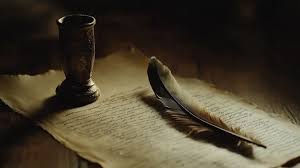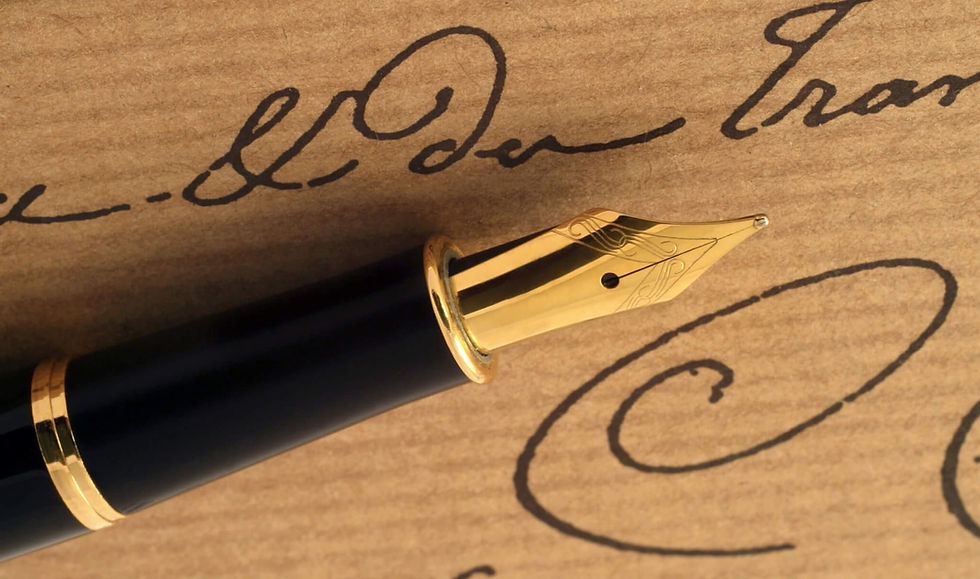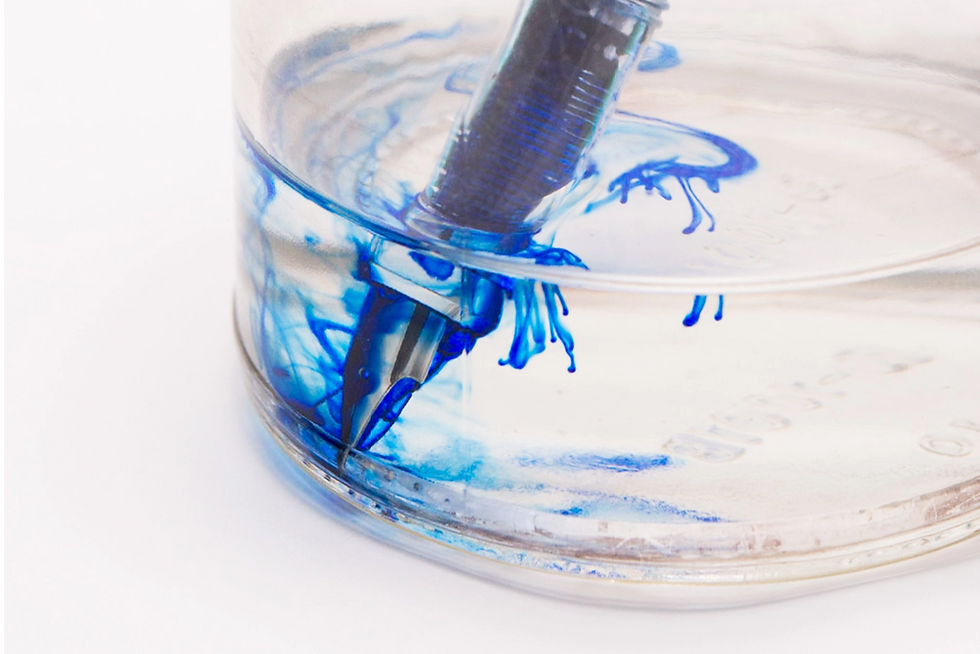From Quill to Cartridge: A Journey Through the Elegant History of the Fountain Pen
- seishinpens
- Jul 13
- 5 min read
In our fast-paced digital age, where keyboards clatter and screens glow, there’s a quiet, almost reverent pleasure in uncapping a fountain pen. The smooth glide of nib on paper, the controlled flow of ink, the subtle scent of the page—it’s an experience that transcends mere writing; it’s an act of connection, a nod to centuries of innovation and artistry. But, what is the history of the fountain pen? Let’s take a look.
The Genesis: A Need for Fluidity

Before the fountain pen, the quill reigned supreme. For over a thousand years, from the 6th to the 19th century, the sharpened feather of a goose, swan, or crow was the primary tool for writing. While effective, quills had their drawbacks: constant sharpening, limited ink capacity (requiring frequent dipping into an inkwell), and a tendency to splatter. The desire for a more continuous and convenient writing experience fueled the earliest attempts at what we now recognize as a fountain pen.
The very first recorded concept for a pen with an internal ink reservoir dates back to 972 AD. Ma'ād al-Mu'izz, the Fatimid Caliph of Egypt, demanded a pen that wouldn't stain his hands or clothes. His vizier, al-Tamimi, obliged, describing a pen that held ink in a reservoir, feeding it to the nib. While the exact design remains a mystery, it highlights an early recognition of the need for an ink-fed system.
Fast forward to the Renaissance, and we see further incremental advancements. Leonardo da Vinci, ever the innovator, sketched designs for a gravity-fed ink pen, though whether he ever built a working model is debated. These early forays, while not mass-produced, demonstrate a persistent human drive to improve the act of writing.
The Dawn of the Modern Fountain Pen: 17th to 19th Centuries

The 17th century brought more concrete developments. In 1636 Daniel Schwenter, a German inventor, described a pen made from two quills, one inside the other, with a cork stopper and a small hole for ink to flow. While still rudimentary, it was a step closer to a self-contained ink system.
The 18th century saw various patents for "fountain pens" or "reservoir pens," though many were still impractical or highly customized. In 1803, the first patent for a fountain pen was granted to Frederick Fölsch in England, featuring an ink-filled barrel and a plunger mechanism. However, these early designs often suffered from unreliable ink flow, clogging, and leakage – issues that would plague inventors for decades.
The real breakthrough came in the 19th century, driven by the Industrial Revolution and a growing demand for literacy and efficient communication. The invention of the steel nib was a game-changer. Prior to this, nibs were made from gold, which was too soft, or quills, which were fragile. Steel nibs, mass-produced and durable, provided a consistent and finer line, making writing more accessible and enjoyable.
However, the Achilles' heel remained the ink delivery system. Many early 19th-century "fountain pens" were essentially just ink reservoirs attached to a conventional dip pen nib. The challenge was to create a reliable capillary action that would allow ink to flow smoothly without either gushing or drying up.
The Golden Age: Lewis Waterman and the Capillary Principle
The year 1884 is often cited as the true birth of the modern fountain pen, thanks to Lewis Edson Waterman. The popular (though possibly apocryphal) story goes that Waterman, an insurance broker, lost a significant sale when his pen leaked all over a crucial contract. Frustrated, he set out to create a better pen.
Waterman's genius lay in his understanding and application of the "capillary principle." He realized that controlling the air and ink flow through a series of channels and grooves (the "feed") was essential. His patented "three-fissure feed" allowed air to enter the ink reservoir as ink flowed out, preventing vacuum lock and ensuring a consistent, controlled stream of ink to the nib. This innovation was revolutionary, transforming the fountain pen from a fickle curiosity into a reliable writing instrument.
Waterman's success spurred a wave of innovation. Other manufacturers, like Parker, Sheaffer, and Conklin, entered the market, each introducing their own improvements. Filling mechanisms evolved from eyedroppers to lever fillers, button fillers, and eventually piston fillers, making the process cleaner and more convenient. Materials also advanced, from hard rubber to celluloid, then to plastics, offering a wider range of colors and designs.
The early 20th century marked the "Golden Age" of the fountain pen. It was a status symbol, an essential tool for professionals, and a cherished possession for many. Iconic models like the Parker Duofold, the Waterman Ideal, and the Sheaffer Balance became synonymous with quality and style.
The Mid-Century Shift and the Rise of the Ballpoint
The mid-20th century brought significant challenges to the dominance of the fountain pen. World War II saw a need for robust, low-maintenance writing instruments for soldiers. This need, coupled with technological advancements, paved the way for the rise of the ballpoint pen.
Developed by László Bíró in the 1930s, the ballpoint pen offered immediate advantages: it was less prone to leaking, dried almost instantly, and could write on a wider variety of surfaces without smudging. Its convenience and affordability quickly made it a mass-market success, and by the 1950s, the ballpoint pen had largely displaced the fountain pen as the everyday writing tool.
Resurgence and Renaissance: The Fountain Pen Today
For decades, the fountain pen seemed destined to remain a niche item, enjoyed primarily by collectors and enthusiasts. However, in recent years, something remarkable has happened: a resurgence, a renaissance of interest in this classic writing instrument.
Several factors contribute to this renewed popularity. In a world saturated with digital communication, the act of writing with a fountain pen offers a tactile, deliberate, and personal experience. It's an antidote to the ephemeral nature of screens, a way to slow down and engage with the written word.
The sheer variety of fountain pens available today is also a draw. From affordable entry-level pens to exquisite, handcrafted masterpieces, there's a pen for every budget and aesthetic. The vast array of ink colors and paper types allows for endless customization and personalization. The online community of fountain pen enthusiasts is vibrant and welcoming, sharing knowledge, reviews, and a shared passion.
Beyond the aesthetics and the tactile pleasure, there's a growing appreciation for the environmental benefits of refillable pens over disposable plastic ballpoints. The fountain pen, with its longevity and refillable ink, aligns with a more sustainable lifestyle.
The Enduring Legacy
From the rudimentary concepts of ancient caliphs to the sophisticated mechanisms of modern masterpieces, the history of the fountain pen is a testament to human ingenuity and our enduring desire for elegant and effective communication. It's a story of persistence, innovation, and a beautiful blend of art and engineering.
In a world increasingly driven by speed and efficiency, the fountain pen offers a gentle reminder of the value of craftsmanship, the joy of a deliberate act, and the timeless beauty of the written word. So, the next time you pick up a fountain pen, remember the rich history it carries, and savor the unique connection it offers between your hand, your thoughts, and the page. It's more than just a pen; it's a legacy.





Comentarios